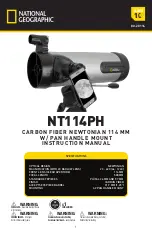
FREQUENTLY ASKED QUESTIONS
1) How far can I see?
If you stand outside and look up at the night sky on a clear evening, you can see
hundreds of stars without the aid of your telescope. The telescope is a light-gathering
instrument that magnifies the view—providing significantly more detail and unveiling
more stars, nebulae, and celestial objects. With the aid of a telescope, you will be able
to enjoy exciting views of Saturn’s rings, Jupiter’s major moons, the Orion Nebula, and
much more.
2) Why can’t I see anything through my telescope?
If you see only gray or black when looking through your telescope, even after searching
for an object to view, it is very likely that you are using a zoom power that is too
powerful. To solve this problem always start with the lowest power first, and only zoom
to the higher powers after you have located an object.
3) When I use my highest zoom power, everything looks much darker. Why?
As magnification in a telescope increases, brightness diminishes. Conversely,
brightness increases when magnification is reduced. If an image appears too dark or
unclear, use a lower power. Views of small, bright objects are superior to those of large,
dark, or blurry ones! Atmospheric conditions, air currents, as well as light and air
pollution also affect viewing quality.
4) As I look through my telescope, objects in the sky appear to move. Why is
that?
When you observe an astronomical subject through a telescope, the constant rotation of
the Earth makes things appear as though they are moving across the viewing area. If
you would like to reduce this effect of movement to a minimum and observe the widest
field of view, you should use lower zoom power.
!
WARNING! CHOKING HAZARD –
Small parts. Not suitable for children
under 3 years.
Made in China
Manual Part #: 264966
National Geographic’s net proceeds support vital exploration,
Experience the National Geographic Channel.
conservation, research, and education programs.
Call your cable or satellite provider for availability.
Visit
our
website:
www.nationalgeographic.com
2004 National Geographic Society. NATIONAL GEOGRAPHIC and Yellow Border are trademarks of National Geographic
Society. All rights reserved.
7

























